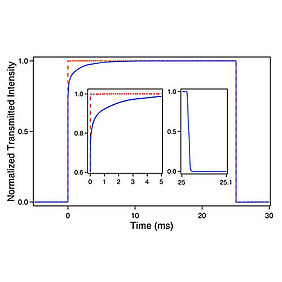"Slow light in saturable absorbers: Progress in the resolution of a controversy" in Physical Review.
DYSCO Vie du labo Parutions
Large audience presentation of the article "Slow light in saturable absorbers : Progress in the resolution of a controversy" published in Physical Review. A 95, volume 6, 063830, 1-9 (2017).
The ruby crystal constitutes a reference medium in optics. Indeed, the first operational laser used a rod of synthetic ruby excited by a flashtube. More recently, the time-delay in the transmission of pulses of green light through such a rod at room temperature has been considered as a demonstration of ultraslow light propagation, comparable to that performed in cold atoms or atomic vapour by electromagnetically induced transparency (velocity extremely small compared to its value in vacuum). However, since more than ten years, this interpretation is the subject of a controversy. Its opponents remark that the transmission delay is very simply explained by the phenomenon of bleaching, widely studied in the 1960s. The delay would then originate in absorption of the leading edge of the pulse larger than that of its trailing edge and, being limited by the time response of the medium, would reflect the slowness of the latter rather than that of the light. This model predicts that, within negligible delays, the transmitted field should be strictly zero when the incident light is switched off but the experiments performed by the defenders of the slow light and of the slow medium gave contradictory results. A team of the PhLAM laboratory and of the CERLA has solved the controversy by revisiting in detail the theoretical and experimental study of the problem. The results of this study, published in Physical Review A, clearly support the bleaching model (slow medium). The authors provide in particular an explanation of the opposite experimental result obtained by the slow light defenders. It appears that the light detected in their experiments was not the transmitted light (green light) but the fluorescence red light emitted by the crystal (the one which originates the laser effect when the crystal is placed inside a resonant cavity).
Bruno Macke , Igor Razdobreev and Bernard Ségard Read also : © The original version of this article was published on Physical Review All rights reserved.

